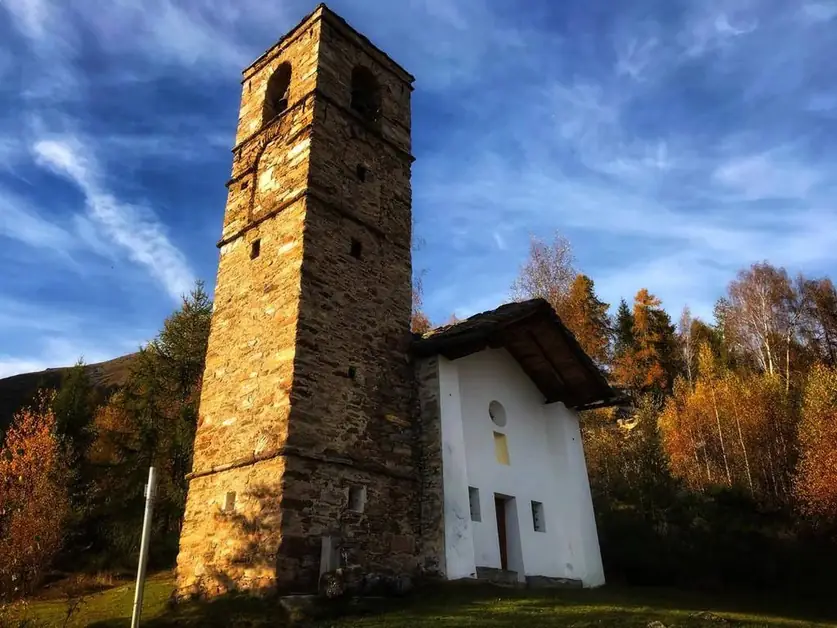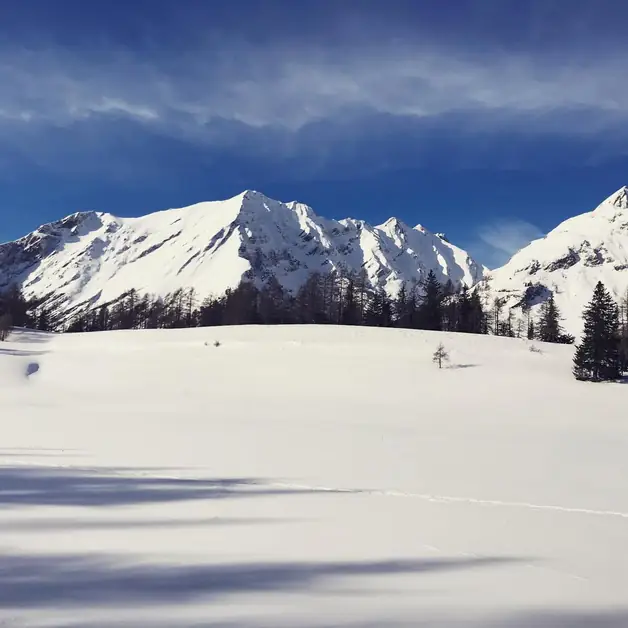The Kiry Chapel a gem in the Aosta Valley
The Kiry chapel is a gem in the Aosta Valley, immersed in nature.

Where is the Kiry chapel located and what makes it so fascinating?
The Kiry chapel is located at an altitude of 1600 meters on the right bank of the Lys stream, in the territory of Fontainemore, in the Aosta Valley. It is easily recognizable for its white color that stands out against the steep slope, framed by woods and alpine pastures. The building stands along the slope leading to the Prial pasture, in a panoramic and solitary position. Its beauty lies in its simplicity and harmony with the surrounding landscape: a small building that stands out against the mountains, immersed in the silence of nature.
Why is the Kiry chapel considered so important in Fontainemore?
The Kiry chapel is the most significant sacred building of the endret (or adret), that is, the left bank of the Lys. In the past, these two areas - endret and envers - represented two distinct worlds of mountain life, separated by the stream but united by the same faith. The Kiry chapel is dedicated to Saint Peter in Chains, whose feast falls on August 1st. It is one of the few cases where the patron is celebrated in the height of summer, a period when the life of the pastures was at its most active. During those days, the shepherds would return to the pastures around the chapel and the inhabited areas, empty in winter, would come alive again.
What is the history of the Kiry chapel?
The origins of the chapel are lost in time. There are no documents that precisely attest to its foundation, but the first official mentions date back to 1753, when the parish archives of Fontainemore already spoke of an ancient sacred building in need of significant restoration. This data suggests that the chapel was already much older. A document from 1799, entitled "État des chapelles rurales", clearly states that the Kiry chapel was “fondée et bâtie l’an 1560”. If this dating is correct, it would mean that the chapel dates back to the second half of the sixteenth century, making it one of the oldest religious buildings in Fontainemore, right after the parish church of Saint Anthony Abbot.
Why was the Kiry chapel built in such an isolated position?
At the time, the chapel was not located in a proper village, but along a mule track that connected the pastures and the Prial alpine pastures with Issime and Perloz. In the past, when travel was done on foot through mountain passes, these paths were very frequented. For travelers, being able to stop in front of a chapel, pray and ask for protection along the way was a deeply rooted custom in mountain culture. The position of Kiry, in a small clearing away from the valley floor, was therefore not casual: it represented a spiritual and geographical reference point for those crossing these mountains.
What is the Kiry chapel like and what elements characterize it?
The chapel is a small white building, with a gabled roof and a bell gable. Its architectural simplicity reflects the tradition of Aosta Valley alpine chapels, built with local materials and adapted to the landscape. Inside, it houses a small altar dedicated to Saint Peter in Chains, depicted with the chains symbolizing his martyrdom. The walls, once frescoed, retain traces of sacred paintings now faded by time. Even though the interior is very simple, the chapel conveys a deep sense of gathering and spirituality.
What does the feast of Saint Peter in Chains represent for the inhabitants of Fontainemore?
The feast of Saint Peter in Chains, celebrated on August 1st, is a very important moment for the inhabitants of Fontainemore and the nearby fractions. In the past, during the summer, the pastures would repopulate and the chapel would become the center of religious and community life in the area. The celebration was an opportunity to reunite families and shepherds who spent months away from the village. Today, the tradition continues: every year, the community gathers at Kiry for an outdoor mass and a day of celebration, with songs, lunches, and convivial moments.
How do you reach the Kiry chapel today?
To reach the chapel, you start from the Capoluogo of Fontainemore, in front of the parish church of Saint Anthony Abbot. From there, you follow trail marker no. 1, which climbs through woods and meadows up to Kiry. The path is well marked and takes about an hour and a half of walking with a height difference of just over 400 meters. Along the way, you cross ancient mule tracks, streams, and small villages, until you reach the clearing where the chapel stands. Nearby, you can also admire some rascards, typical Aosta Valley wooden constructions resting on stone pillars with the characteristic “mushrooms” that served to protect supplies from rodents.
What view can be admired from Kiry?
The panoramic position of the chapel allows you to enjoy a magnificent view of the entire Lys Valley. From the meadow in front, you can admire Monte Mars, the highest peak of the reserve, and the slopes that descend towards Fontainemore and Perloz. In autumn, the woods turn red and gold, creating a spectacular contrast with the white of the sacred building. In winter, however, the snow transforms the landscape into an almost mystical vision.
What is the spiritual significance of the Kiry chapel?
The chapel has represented for centuries a place of faith and gathering, but also a symbol of the relationship between man and the mountain. For generations, shepherds and travelers have stopped there to ask for protection and to give thanks for the journey. Even today, those who arrive at Kiry perceive a deep sense of peace, as if time has stood still. It is a place that invites reflection and gratitude, immersed in a silent and powerful nature.
